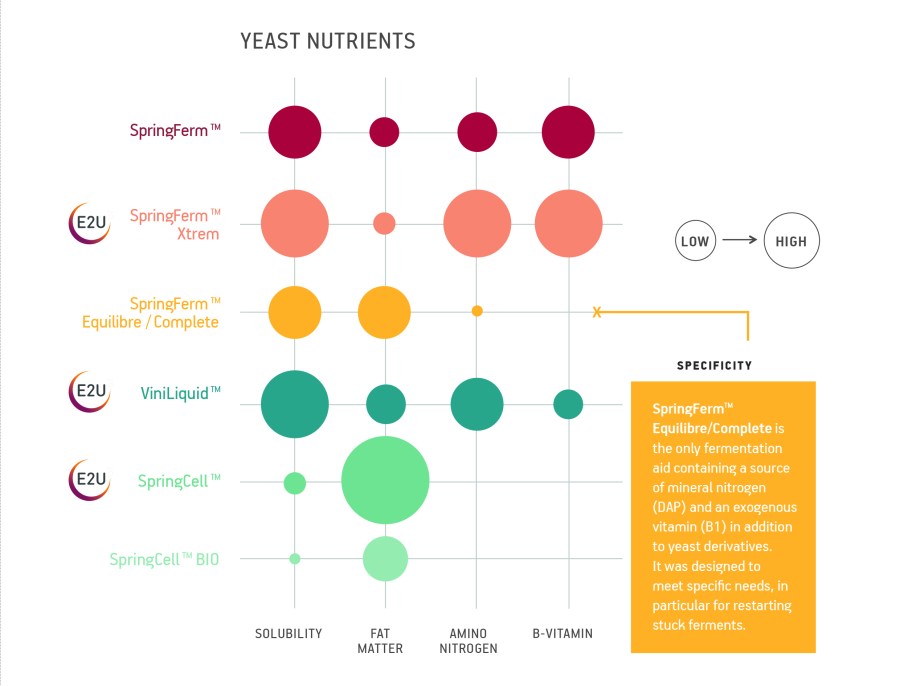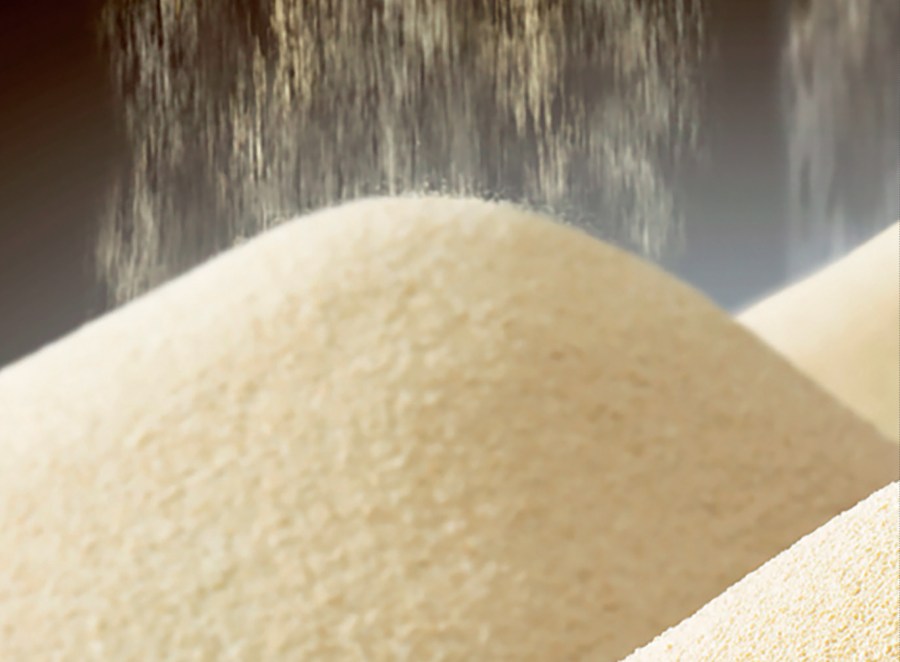Yeast and bacteria are living organisms, like us they need food to survive and a balanced diet ensures a healthier, longer life; one cannot live on sugar alone. If the yeast do not have sufficient nutrition they can struggle – leading to stuck or sluggish fermentation as a result of hydrogen sulphides (H2S) production. Typical H2S aromas range from struck match through cabbage to sauerkraut all the way to rotten eggs – a small amount of reduction can be tolerated in some wine styles but too much is most definitely not desired in sparkling base wines where the inevitably reductive secondary fermentation can compound the problem.
I was invited to attend a Fermentis Academy Seminar that was to be held at Plumpton College in early July – for various reasons the in-person event was postponed but I had the chance to interview Dr Maryam Ehsani PhD to hear about the latest research in the world of yeast and nutrition, in particular the products being developed by Fermentis. A relative newcomer to the UK market, Fermentis is a fermented-beverages dedicated business unit of Lesaffre, one of the largest yeast producers for bread (arguably as important a topic as wine in France). Their oenological products are represented in the UK by Vigo Ltd.
Maryam’s presentation is too detailed to be fully summarised in this short article, but I have picked out the pertinent points I feel are most important for the UK industry, inevitably weighted towards sparkling base wines as that is my speciality but with the increasing number of red, white and rosé wines being made, consideration for proper yeast nutrition adapted to wine style becomes more relevant.
Winemakers have long been supplementing yeast’s diet with nitrogen. Measuring the Yeast Available Nitrogen (YAN) in the grape juice at pressing allows the winemaker to fine tune any additions needed or make the decision that perhaps no addition is required. Testing for YAN is relatively cheap when considering the problem one might get from reduction as a result of a sticky fermentation but it does require specialist lab equipment and a skilled operator in order to get accurate results. Sending off samples for testing in an outside lab adds time and another layer of admin during the busy harvest period, so it is tempting for winemakers to simply add a nutrient addition to the work order for inoculation as a ‘belt and braces’ approach. Most commercially available nutrient additions are diammonium phosphate (DAP) or mineral nitrogen (NH4+). DAP could be described as the Big Mac of yeast food, whereas the naturally occurring nitrogen in the grapes is made up of about two thirds organic nitrogen (amino acids). Once fermentation is underway the yeasts are not fussy about whether their food is organic or not but the type of nitrogen they are fed may have an effect on the resulting flavour profile. The addition of amino acids (organic) has been shown to increase thiols whilst DAP (mineral), in excess and higher amounts than organic nitrogen at the beginning of AF, has the opposite effect and represses them. In making base wines you may wish to avoid such an increase whilst making aromatic whites it may well be highly desirable to increase the production of thiols.
The amount of YAN that the yeast requires to successfully complete fermentation depends on the alcohol level to which they are expected to ferment as well as the type of yeast being used. The commonly used ‘champagne’ strains such as Fermentis SafŒno SPK 05, IOC 18-2007 and Lalvin EC-1118 have lower requirements than other yeasts identified more typically for still wine ferments. Sparkling base wines are normally only expected to ferment to 11% maximum so YAN requirements will be lower than a still wine at 12% or more. As a guide, a juice with a potential alcohol of 12% will require around 200mg/L of YAN.
In addition to the formation of hydrogen sulphides a lack of YAN can cause the struggling yeast to produce higher levels of volatile acidity (VA). With there being legal limits on VA in a finished wine, if you needed another reason to check your YAN at juice stage, this should also help you decide how important nutrition is – see graph on page 46.
As a winemaker operating in England, mainly making sparkling wine from the classic varieties of Chardonnay, Pinot Noir and Pinot Meunier I have been guilty of testing one or two juice samples for YAN at the beginning of harvest and then applying the same nutrient protocol to all subsequent batches, even adding when the figures tell me it is not strictly necessary – just in case… In my experience, it is rare to see YANs below 200mg/L in the classic varieties but the aromatic whites and other varieties may be more susceptible to the soil and microclimate where they are grown. Bacchus from one vineyard may be happily sufficient whilst the crop from another site will be woefully low and need significant adjustment to avoid problems.
Maryam’s presentation highlighted one thing I had not previously really considered; excess nitrogen causing the very problem the addition is trying to avoid. A must or juice can have a sufficiently high YAN but without some other crucial ingredients in the mix the yeast can still struggle and produce unsavoury levels of H2S. Vitamin B5 (pantothenate) is one key element that is found naturally in yeast-derived nutrients and maximises the effectiveness of the nitrogen.
Too much nitrogen added at the beginning of a fermentation can cause the yeast to reproduce excessively, lead to reduction or die too rapidly, particularly in musts depleted of lipids (fatty acids and sterols). Highly clarified musts may remain high in YAN but low in lipids. Hence the conundrum a winemaker may face with a stuck or reductive ferment even though YANs showed to be at a good level in the juice. In the case of a must with initially high YAN, no addition should be made at the beginning, with a timely addition of YAN at one third of the fermentation/at the beginning of the stationary phase to ensure the biomass of yeast will have enough food to carry through to the end.
Another factor, which most winemakers work out for themselves pretty quickly, is the timing of the addition of any nutrient. Fermentis advise adding enough nitrogen at the end of the lag phase, just before the acceleration stage to give a YAN of around 150mg/L with a second addition at the beginning of the stationary phase to feed the increased biomass.
Fermentis has a catalogue of products that are designed to work with must and yeast in order to improve the kinetics of your fermentation. Each product will have a slightly different goal. Highly clarified musts may benefit from SpringCellTM, deactivated yeast hulls that will provide support to the yeast but not add to the initial YAN where unnecessary. SpringFermTM Equilibre, derived from autolyzed yeasts will provide YAN in both organic and mineral forms along with amino acids, sterols, B vitamins and lipids to fully support deficient musts. SpringFermTM on the other hand, is a partial yeast autolysate-based nutrient, preserving a good balance between organic and mineral nitrogen.
SpringFermTM Xtrem is a stronger version of SpringFermTM devised for very ripe grapes with low YAN and high potential alcohol – maybe a product that will come into its own as we see increasingly ripe grapes arrive in the winery. See the table above.
All of these products have legal limits on their use so do ensure you read the guidelines for addition rates. Most importantly check your YANs this harvest – if 2023 really is going to be another 2018 getting the nutrition optimised for successful fermentation will be vital.





